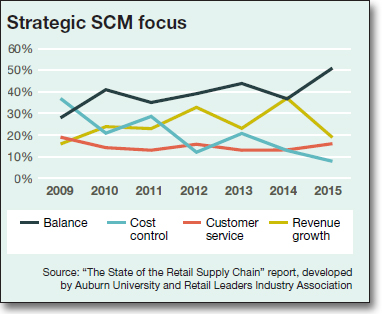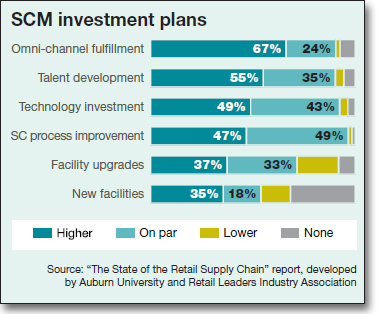Key Trends Taking Place in the Retail Supply Chain

The ability to ship anything from anywhere and to anywhere within a short timeframe isn’t the only trend that’s shaping the retail supply chain right now.
Rewind about two years and Brian J. Gibson remembers attending a retail conference in Reno, Nev., where he talked to a panel of executives about their top challenges and issues.
When the Wilson Family Professor of Supply Chain Management at Auburn University posed the questions, “How do you fulfill customers’ online orders and, do you look at transportation costs and fulfillment costs and then offer them choices?” he was taken aback by the responses.
“They basically said, ‘It’s whatever the customers want. If they want to pick it up in the store, then they pick it up in the store. If they want it delivered to their house, we’ll deliver it to their house,’” Gibson recalls: “There was literally no focus on the cost aspect of it, or on what the most efficient or optimal approach would be.”
Today’s retailers are decidedly more focused on the fine points of the “anytime, anywhere” approach to fulfillment, and with good reason.
The exploding omni-channel trend, the demanding consumer who wants everything yesterday, and the evolving regulatory market are all forcing companies to look harder not only at how goods are being shipped, but also on why certain methods are used and what they could be doing better in this regard.
“We’re seeing a much greater focus on understanding and managing fulfillment costs and an attempt to shape customers’ actions, decisions and activities based on the best possible solutions,” says Gibson. “Retailers look not only at what’s viable, they also want the options that are lowest in cost while meeting customers’ requirements.”
And while Gibson clearly sees more rationality around omni-channel fulfillment than there was just two or three years ago, the ability to ship anything from anywhere and to anywhere within a short timeframe isn’t the only trend that’s shaping the retail supply chain right now.
At his recent SDI Logistics Forum presentation entitled “Retail Fulfillment: Doing More with Less,” Gibson highlighted the results of his fifth-annual “State of the Retail Supply Chain (SRSC)” report.
Trend Spotting
In the report, Gibson outlines seven key supply chain trends or “lessons” that retailers are grappling with right now.
1. Inventory: Customers want buy-from-anywhere flexibility and an endless aisle of products. Retailers desire single inventory pool to control investment. Key challenges for retailers include system-wide visibility, in-store accuracy levels, technology capabilities and DC integration activities.
2. Labor: The cost of employment and labor turnover issues justify a new model for DC operations. To solve this issue, retailers should analyze ROI for automation opportunities. To achieve this goal, retailers have to be able to justify major investments and integrate omni-channel operations.
3. Time: Customers expect an array of rapid fulfillment options and no-cost delivery. Retailers must match capacity and capabilities to volume and service requirements. To make that happen, retailers must be able to meet true demand for same-day and offer fast vs. free alternatives and store delivery frequency.
4. Space: Creating separate fulfillment facilities for uncertain volume carries significant risk. To overcome these issues, retailers must fully use existing infrastructure capacity to compete. Achieving this goal can be difficult due to the breadth of SKU assortment and volume by channel.
5. Transportation capacity: Carriers are more selective about lanes served and strategic customer relationships. Retailers must be creative and think long-range when developing transportation strategies. The problem is that innovation options are limited and some retailers continue to be plagued by the aftermath of port disruption.
6. Transportation cost certainty: In 2015, we saw the implementation of dimensional (DIM) weight pricing. Retailers have been since assessing the impact of this new parcel pricing strategy. Key challenges include the volume of split ships, store personnel training and packaging options at stores.
7. Margin for error: Fulfillment missteps are very costly and highly publicized events that erode margins and consumer confidence. Retailers must reduce complexity and expense of supply chain operations. To achieve these goals, companies must work through issues like fulfillment and delivery cost control and low customer switching efforts.
“I focused on some of the key issues that we’ve seen over the last few years in our annual retail study, plus the 2015 version of the study,” says Gibson, who typically interviews retail supply chain executives from 25 to 30 companies (plus another 50 who answer the survey) and then uses the information gathered to develop the report. “We hit a lot of the top 100 U.S. retailers and get the perspectives of the big industry players; a lot of the trends and issues we uncover eventually [impact] the smaller retailers as well.”
During his research, which took place during the fall of 2014, Gibson heard a lot of complaints about the port strike that was in full swing at the time. “That was obviously one of the most important themes,” he notes, “but certainly other transportation issues came up as well.” Carrier capacity, for example, was top of mind for survey respondents who were concerned about their firms’ ability to secure capacity in 2015 and beyond.
Two other big areas of concern were materials handling and omni-channel fulfillment trends.
In the materials handling arena, Gibson says one of the biggest changes that’s occurred over the last few years is the significant shift in attitudes and actions regarding the use of warehouse automation.
Two years ago, for example, companies were having a hard time justifying the capital investments associated with such purchases and often griped that the ROI “didn’t meet the thresholds for their companies,” says Gibson. “Now, two years later, everyone is either investigating the use of automation or already in the mindset of using it. That’s a 180-degree turn since 2013.”
Driving that warehouse automation trend, says Gibson, are factors such as rising labor costs, availability of labor, and the speed and flexibility with which individual orders need to be picked, packed and shipped. “Even grocery retailers are fulfilling at the individual level - a shift that’s pushing almost 100% automation of warehouse operations,” he explains. “That’s pretty interesting.”
What’s Old is New Again
All of the warehouse automation and omni-channel fulfillment capabilities in the world can’t cover up a poor transportation network or warehouse operations.
This basic fact was revealed in the report. “If you don’t have the fundamental distribution issues covered, the innovative technologies and solutions can’t help you,” says Gibson. “You have to be able to manage the basics of freight movement, capacity, inventory accuracy, and labor productivity very closely and very well. You can’t jump ahead or forget about the basics as you move forward.”
Gibson sees labor issues as a particularly onerous for retailers trying to develop and leverage effective, omni-channel-centric supply chains. “These issues aren’t going away anytime soon,” he adds. “As the economy continues to improve, people are going to want to work in manufacturing versus fulfillment, logistics and transportation.”
To offset this obstacle, companies will have to come up with innovative and creative ways to fill positions, retain key employees and develop effective succession plans. The latter is particularly relevant in today’s workforce, where a high percentage of the nation’s 78 million Baby Boomers are already heading into retirement.
“Where’s the young talent?” asks Gibson. “Where are the up-and-comers? A lot of schools are working to develop this talent, but we’re definitely seeing a void of high-caliber talent in the middle management group (aged 30 to 40+) right now. That’s definitely a concern for retailers who need those sharp people to run their supply chains.”
Calling the 2014 retail landscape “bipolar,” with U.S. retail sales up 3.8% for the year, paced by a 15.4% gain in e-commerce sales over the previous year, Gibson says the latter captured the focus of retail supply chain management professionals as they worked diligently to create seamless omni-channel processes.
“Despite the periodic challenges created by port issues, transportation capacity and labor shortages, and other disruptors,” says Gibson, “retail supply chain executives are moving forward with essential investments, infrastructure modifications and service improvements.”
RFID Rebirth
As 2015 slowly sets and 2016 comes into focus on the horizon, more changes could be in order for the retail supply chain. For example, Gibson sees a rebirth currently taking place on the radio frequency identification (RFID) side of things - a movement that “died on the vine” a few years ago due to the high cost of RFID tags and other issues.
“Over the last six months we’ve heard more companies talking about how they need RFID for inventory accuracy,” says Gibson, “knowing that if they commit to having units in a store for a customer, they’ll have to fill that order for pickup. When the customer gets there, the retailer had better be able to find that product and quickly.”
Calling RFID a “new link in capability,” not just to support inventory accuracy, but also to support omni-channel fulfillment at the store level, Gibson says the technology - which is already being used by large retailers like Target and Macy’s - helps retailers stick to their customer commitments. “It’s helping them retain and grow sales.”
Related: How Supply Chains Can Keep Up With Today’s Retail Consumer Demands

Article Topics
Auburn University News & Resources
RFID company Tageos joining Auburn University RFID Lab advisory board Auburn’s Harbert College of Business creates Department of Supply Chain Management Key Trends Taking Place in the Retail Supply Chain The State of the Retail Supply Chain 2015 The state of the retail supply chain 60 seconds with Brian Gibson, Auburn University Automation: E-commerce, software and maintenance at SELF15 More Auburn UniversityLatest in Supply Chain
Microsoft Unveils New AI Innovations For Warehouses Let’s Spend Five Minutes Talking About ... Malaysia Baltimore Bridge Collapse: Impact on Freight Navigating TIm Cook Says Apple Plans to Increase Investments in Vietnam Amazon Logistics’ Growth Shakes Up Shipping Industry in 2023 Spotlight Startup: Cart.com is Reimagining Logistics Walmart and Swisslog Expand Partnership with New Texas Facility More Supply ChainAbout the Author


















